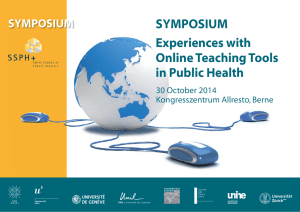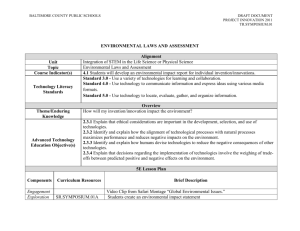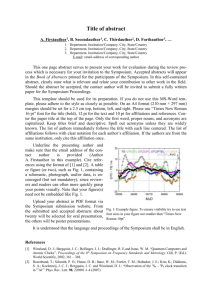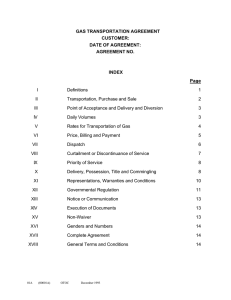environmental impact of innovations
advertisement
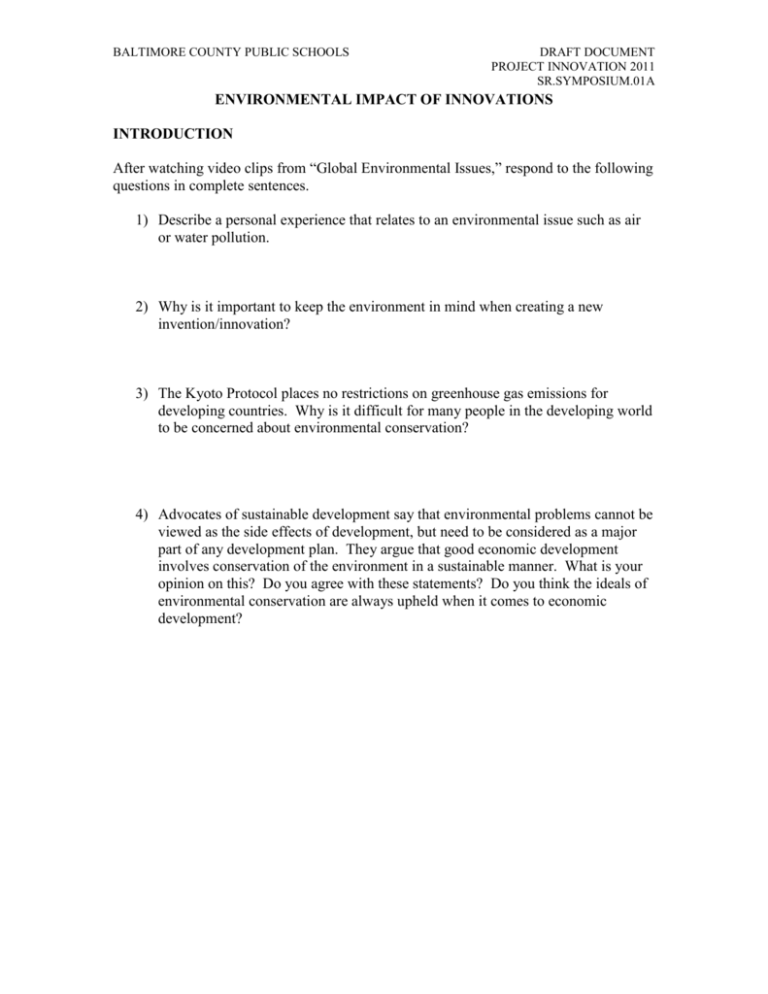
BALTIMORE COUNTY PUBLIC SCHOOLS DRAFT DOCUMENT PROJECT INNOVATION 2011 SR.SYMPOSIUM.01A ENVIRONMENTAL IMPACT OF INNOVATIONS INTRODUCTION After watching video clips from “Global Environmental Issues,” respond to the following questions in complete sentences. 1) Describe a personal experience that relates to an environmental issue such as air or water pollution. 2) Why is it important to keep the environment in mind when creating a new invention/innovation? 3) The Kyoto Protocol places no restrictions on greenhouse gas emissions for developing countries. Why is it difficult for many people in the developing world to be concerned about environmental conservation? 4) Advocates of sustainable development say that environmental problems cannot be viewed as the side effects of development, but need to be considered as a major part of any development plan. They argue that good economic development involves conservation of the environment in a sustainable manner. What is your opinion on this? Do you agree with these statements? Do you think the ideals of environmental conservation are always upheld when it comes to economic development? BALTIMORE COUNTY PUBLIC SCHOOLS DRAFT DOCUMENT PROJECT INNOVATION 2011 SR.SYMPOSIUM.01A DIRECTIONS 1) Read the following excerpt from the Environmental Literacy website. 2) After reading, answer the following questions in complete sentences. An environmental impact analysis is typically conducted to assess the potential impact a proposed development project will have on the natural and social environment. This may include an assessment of both the short- and long-term effects on the physical environment, such as air, water and/or noise pollution; as well as effects on local services, living and health standards, and aesthetics. In enacting the National Environmental Policy Act (NEPA) of 1969, Congress required all agencies of the Federal government to give equal consideration to environmental consequences as well as to economic motivations and technological feasibility when making a decision that could affect the quality of the human and natural environment. NEPA also established the Council on Environmental Quality within the Executive Office of the President to ensure that federal agencies would meet their obligations under the Act. One provision of the law requires that an Environmental Impact Statement (EIS) be written for major federal actions and made available to all, including to the general public. An EIS must include: • the environmental impacts of a proposed action • unavoidable adverse environmental impacts • alternatives, including no action • the relationship between short-term uses of the environment and maintenance of long-term ecological productivity • irreversible and irretrievable commitments of resources • secondary/cumulative effects of implementing the proposed action. Now, most state and local governments also require that environmental impact analyses be conducted prior to any major development projects. Environmental impact analyses are often challenging because they call for making projections with incomplete information. Methods of assessing the impacts typically include both objective and subjective information making it difficult to quantify. Therefore, the methods are frequently seen as complex and, oftentimes, controversial. Despite being a requirement for many development projects, the function of an environmental impact statement is merely procedural. There is no specific legal force of action if information stemming from an environmental impact analysis confirms that a particular project may harm the environment. As a result, it is often left up to the courts to rule on whether risks to the environment are overstated or not. Although an environmental impact analysis often raises more questions than it answers as it examines the various links between social, economic, technological, and ecological factors involved in a potential development project, it also provides a practical and BALTIMORE COUNTY PUBLIC SCHOOLS DRAFT DOCUMENT PROJECT INNOVATION 2011 SR.SYMPOSIUM.01A interesting approach to the understanding and appreciation of the many complexities and uncertainties involved with these interrelationships. 1) What is the purpose of an environmental impact analysis? 2) Why would parts of the environmental impact analysis be based upon assumptions? 3) Is there a way to limit the amount of assumptions made? Explain. EXPLORE Use the website, http://www.lic.wisc.edu/shapingdane/facilitation/all_resources/impacts/analysis_environ mental.htm to further research environmental impact analysis. Follow the steps and use the chart to successfully create your own environmental impact analysis. ENVIRONMENTAL IMPACT ANALYSIS Define the Scope of Environmental Impact Assessment BALTIMORE COUNTY PUBLIC SCHOOLS Inventory Community natural resources, their quality and current use Compile and review existing community environmental management standards and guidelines DRAFT DOCUMENT PROJECT INNOVATION 2011 SR.SYMPOSIUM.01A BALTIMORE COUNTY PUBLIC SCHOOLS Assess the extent and significance of environmental impacts resulting from the proposed development Evaluate the potential cumulative impacts associated with the proposed development DRAFT DOCUMENT PROJECT INNOVATION 2011 SR.SYMPOSIUM.01A

